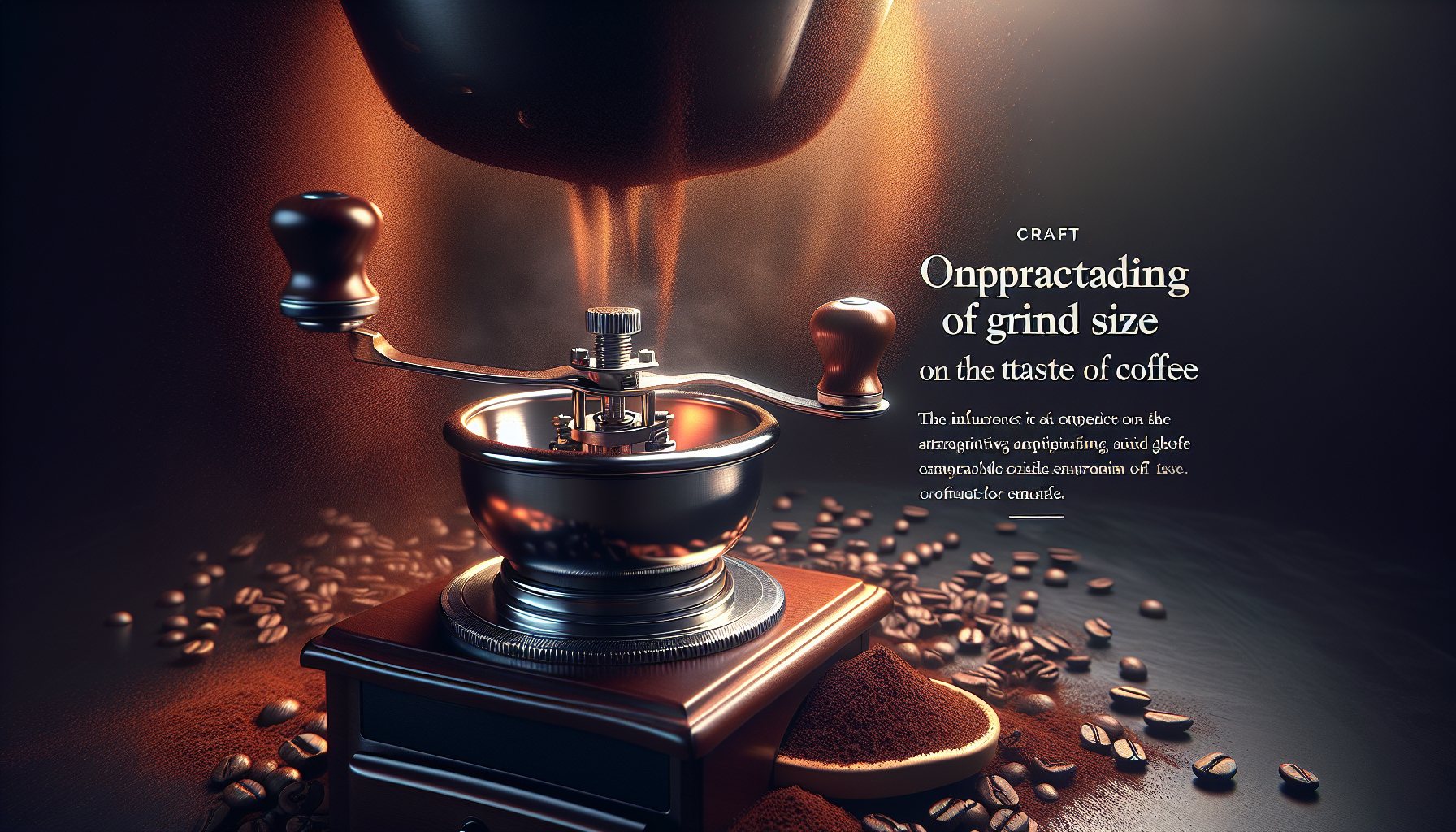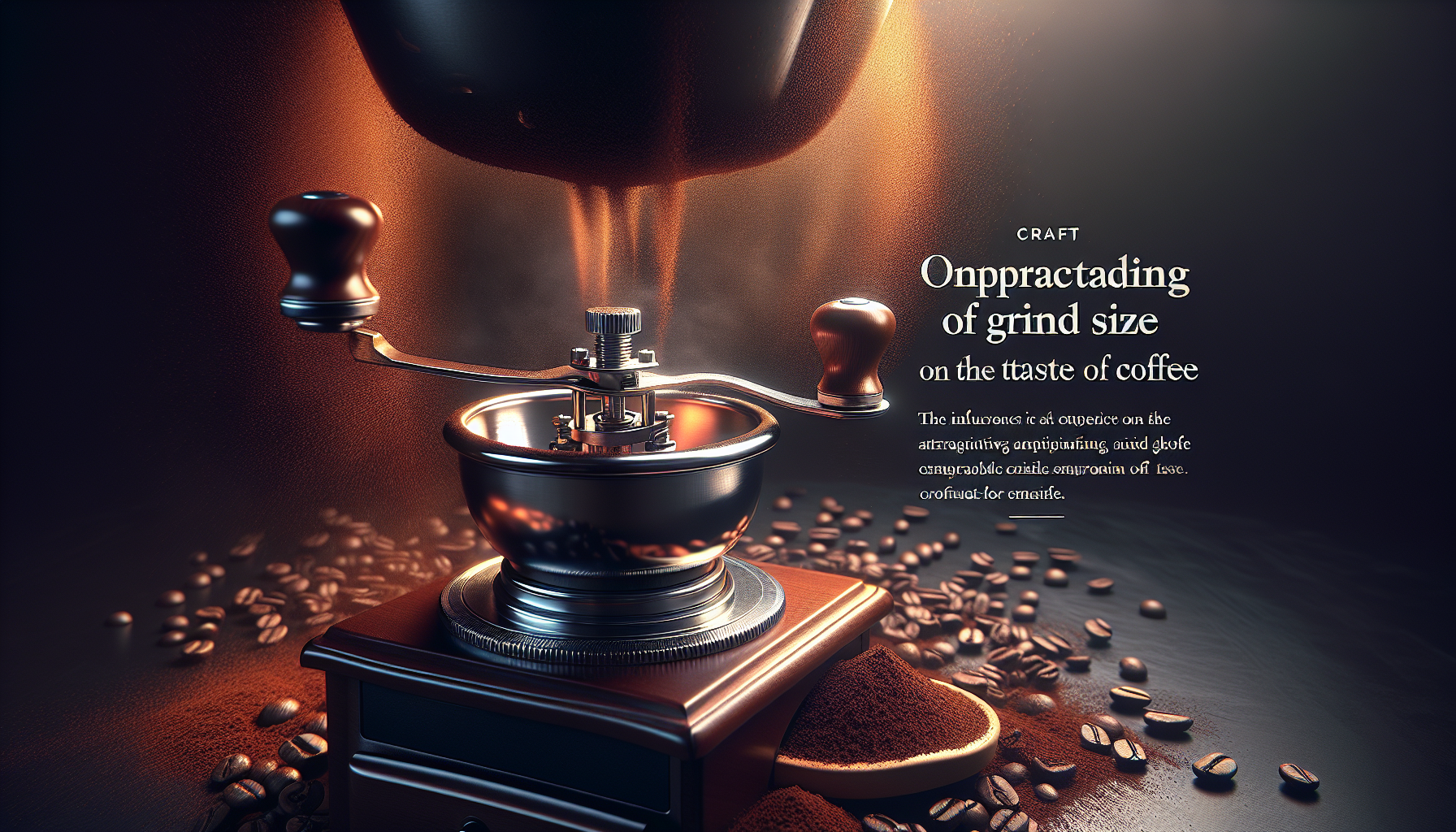Imagine starting your day with a fresh cup of coffee, its rich aroma filling the air as you prepare for the day ahead. But have you ever wondered if the way you grind your coffee beans could affect its flavor? In the quest for the perfect cup of joe, the question arises: does grinding coffee finer make it more bitter? Let’s explore the fascinating world of coffee grinding and uncover the truth behind this popular belief.

CHECK OUT COFFEE GRINDERS ON AMAZON
Grinding Coffee Beans: An Overview
What is grinding coffee?
Grinding coffee is the process of breaking down whole coffee beans into smaller, more manageable particles. This can be done using various methods and equipment, such as a grinder or a mortar and pestle. The goal of grinding coffee is to increase the surface area of the beans, which allows for better extraction of flavors during the brewing process.
Why is grinding coffee important?
Grinding coffee is an essential step in the coffee brewing process as it directly influences the flavor and quality of the resulting cup of coffee. By grinding coffee beans, you expose the flavors and aromas locked within the beans, making them more accessible to hot water during brewing. The size and consistency of the grind also play a crucial role in extracting the desired flavors and avoiding potential bitterness.
Different methods of grinding coffee
There are various methods available for grinding coffee, each yielding different grind sizes and textures. The most common methods include blade grinders, burr grinders, and hand grinders. Blade grinders chop the coffee beans into uneven particles, while burr grinders crush the beans between two abrasive surfaces to achieve a more consistent grind. Hand grinders offer control over the grind size, allowing for customization based on personal preferences.
Factors influencing grind size
Several factors influence the grind size, including the brewing method, duration of extraction, bean origin, and roast level. Different brewing methods, such as espresso machines, French presses, or pour-over drippers, require different grind sizes to optimize flavor extraction. The duration of extraction, which depends on the brewing method, can also affect the grind size choice. Additionally, the origin and roast level of the coffee beans can influence the ideal grind size for unlocking their unique flavors.
Understanding Coffee Flavor
The role of coffee particles in flavor extraction
The flavor extraction process in coffee brewing depends on the interaction between the water and the coffee particles. When hot water comes into contact with coffee particles, it extracts soluble compounds such as oils, acids, and sugars, which contribute to the flavor profile of the coffee. The size and consistency of the ground particles are instrumental in determining how much flavor is extracted during brewing.
Extraction process and its impact on taste
During the extraction process, water dissolves and absorbs compounds from the coffee grounds, resulting in the flavors that we taste in the final cup. If the grind size is too coarse, the water will pass through the grounds too quickly, leading to under-extraction and a weak, watery taste. On the other hand, if the grind size is too fine, the water will struggle to pass through the grounds, leading to over-extraction and a bitter, unpleasant taste.
How grind size affects flavor
Grind size plays a significant role in determining the flavor profile of a cup of coffee. Finer grind sizes tend to extract more flavor compounds but can also lead to over-extraction and increased bitterness. Coarser grind sizes, on the other hand, extract fewer flavor compounds, resulting in a milder taste. Achieving the right balance of extraction, with a grind size that matches the brewing method, is key to producing a well-rounded and flavorful cup of coffee.
Exploring the Relationship Between Grind Size and Bitterness
The perception of bitterness
Bitterness is an essential component of coffee flavor, but it can also be a subjective and polarizing aspect for some coffee drinkers. The perception of bitterness in coffee is influenced by individual taste preferences, the coffee bean’s origin and roast level, and the brewing parameters, including grind size. While some individuals may enjoy a slightly bitter taste, others may find it off-putting.
How grind size impacts bitterness
Grind size plays a significant role in determining the level of bitterness in coffee. Finer grind sizes increase the surface area, which can lead to over-extraction and heightened bitterness if the brewing parameters are not adjusted accordingly. On the other hand, coarser grind sizes result in less extraction and a milder, less bitter taste. Experimenting with different grind sizes can help coffee enthusiasts find their preferred level of bitterness.
Scientific studies and findings
Scientific studies have been conducted to explore the relationship between grind size and bitterness in coffee. One study found that finer grind sizes tend to result in increased bitterness, while coarser grind sizes produce a smoother and less bitter taste. However, it is important to note that individual taste perceptions can vary, and personal preferences should be taken into account when determining the optimal grind size for desired flavor.
Optimal Grind Size for Desired Flavor
Finding the right grind size
Finding the right grind size involves experimentation and understanding personal preferences. It is recommended to start with the grind size suggested for the specific brewing method and then make adjustments based on taste. Finer grind sizes are generally used for espresso and Turkish coffee, while coarser grind sizes are suitable for French press or cold brew methods. Tweaking the grind size can help achieve the desired balance of flavors and avoid excessive bitterness.
Matching grind size to brewing method
Each brewing method requires a specific grind size to achieve the best flavor extraction. Espresso machines, for example, require a fine grind size to optimize the extraction time and pressure. Pour-over methods such as Chemex or V60 benefit from a medium grind size, allowing for a balanced extraction. French press and cold brew methods typically call for a coarser grind size to avoid over-extraction. Adapting the grind size to match the brewing method ensures a more satisfying and flavorful cup of coffee.
Impact of grind size on aroma and acidity
Grind size not only affects the flavor profile but also plays a role in the aroma and acidity of coffee. Finer grind sizes tend to enhance the aroma, as more surface area is exposed, allowing the volatile compounds responsible for fragrance to be released. Additionally, finer grind sizes can result in a higher perceived acidity, contributing to a brighter and more vibrant flavor profile. Coarser grind sizes, on the other hand, may yield a milder aroma and slightly lower acidity.
Variables Beyond Grind Size: Considerations for Bitterness
Coffee bean quality and roast level
Apart from grind size, coffee bean quality and roast level are crucial factors that impact the bitterness of coffee. High-quality beans, which are properly roasted, tend to have a more balanced and nuanced flavor profile, with bitterness that is well-integrated and not overpowering. Conversely, lower-quality beans or over-roasted beans can result in a harsher and more unpleasant bitterness. It’s important to select beans of good quality and choose a roast level that complements your taste preferences.
Water temperature and contact time
Bitterness can also be influenced by the brewing parameters, including water temperature and contact time. Using water that is too hot can lead to over-extraction and excessive bitterness. Similarly, allowing the coffee grounds to come into contact with hot water for an extended period can result in increased bitterness. It is recommended to follow specific brewing guidelines and adjust variables such as water temperature and contact time to achieve the desired flavor profile.
Brewing equipment and techniques
The brewing equipment and techniques employed can also impact the bitterness of coffee. Different brewing methods, such as immersion brewing or percolation, can result in varying levels of bitterness due to differences in extraction dynamics. Additionally, using certain brewing accessories, such as paper filters or metal filters, can contribute to differing levels of bitterness. Experimenting with different equipment and techniques allows for customization and the ability to tailor the bitterness to personal preferences.
Tips for Avoiding Bitterness in Coffee
Using freshly roasted coffee beans
To ensure a fresh and flavorful cup of coffee, it is advisable to use freshly roasted coffee beans. Coffee beans gradually lose their flavor and can develop a stale taste over time. By using recently roasted beans, you can enhance the overall quality of your coffee and reduce the likelihood of bitterness caused by stale beans.
Proper storage and grinding techniques
Proper storage and grinding techniques are essential for maintaining the quality and flavor of coffee beans. Storing coffee beans in airtight containers away from heat, light, and moisture helps to preserve their freshness. When grinding coffee, it is recommended to do so just before brewing to prevent excessive exposure to air. This minimizes the risk of oxidation and preserves the delicate flavors, resulting in a more enjoyable, less bitter cup of coffee.
Experimenting with water-to-coffee ratio
Adjusting the water-to-coffee ratio is another way to control the bitterness in coffee. Increasing the ratio of water to coffee can dilute the concentration of soluble compounds extracted during brewing, resulting in a milder and less bitter taste. Conversely, decreasing the ratio can lead to a stronger, more pronounced flavor, potentially tipping the balance towards bitterness. Experimenting with different ratios allows for fine-tuning and customization according to personal preferences.
Adapting brewing parameters
Brewing parameters, such as water temperature, brew time, and extraction method, can significantly affect the bitterness of coffee. Making slight adjustments to these parameters can help achieve a balance between extraction and bitterness. Lowering the water temperature or reducing the brew time can minimize over-extraction and bitterness. It is important to note that small changes can have a significant impact on the final cup, so it may require some experimentation to find the optimal brewing parameters for desired flavor.
Other Factors Affecting Flavor Profile
Acidity and sweetness in coffee
Coffee flavor is not solely reliant on bitterness; acidity and sweetness also play important roles. Acidity adds brightness and vibrancy to the flavor profile, while sweetness contributes to a balanced and pleasant taste. The coffee bean’s origin, roast level, and brewing parameters all influence these aspects of flavor. Properly adjusting the variables can help highlight the desired acidity and sweetness, creating a well-rounded and enjoyable cup of coffee.
Body and mouthfeel
The body and mouthfeel refer to the weight and texture of the brewed coffee in the mouth. These characteristics can vary depending on the coffee beans’ origin, roast level, and brewing method. Finer grind sizes tend to result in a fuller body and heavier mouthfeel, while coarser grind sizes may yield a lighter and more delicate texture. Finding the right balance of grind size and brewing method can help achieve the desired body and mouthfeel in your coffee.
The influence of brewing time
Brewing time, or the duration of contact between water and coffee grounds, can impact the overall flavor profile. Longer brewing times can lead to increased extraction and potentially heightened bitterness. Conversely, shorter brewing times may result in under-extraction, leading to a weaker and less pronounced taste. Finding the optimal brewing time, depending on the desired flavor and preferred brew method, is crucial in achieving the desired flavor balance.
Common Misconceptions About Grinding Coffee Beans
The myth of ‘the finer, the stronger’
One common misconception is that grinding coffee beans finer will result in a stronger and more intense cup of coffee. While finer grind sizes can potentially extract more flavor compounds, creating a bolder taste, they can also lead to over-extraction and increased bitterness. Strength and intensity should not be solely equated with grind size but rather a balanced combination of extraction, aroma, acidity, and body.
Understanding strength vs. bitterness
Strength and bitterness are often used interchangeably when discussing coffee, but they are not synonymous. Strength refers to the concentration of coffee solubles, resulting in a more robust and flavorful cup. Bitterness, on the other hand, arises from over-extraction or the presence of certain compounds. It is possible to have a strong, flavorful coffee with minimal bitterness, provided the right brewing parameters and grind size are employed.
Exploring the ‘sweet spot’ for grind size
The ‘sweet spot’ for grind size is the point at which the coffee extraction leads to a well-balanced cup with optimal flavor and minimal bitterness. This sweet spot can vary depending on personal preferences, brewing method, and specific coffee beans. It is important to experiment with different grind sizes and brewing techniques to find the sweet spot that suits your taste and produces the most enjoyable cup of coffee.
CHECK OUT COFFEE GRINDERS ON AMAZON
Expert Opinions and Insights
Views from coffee professionals
Coffee professionals offer valuable insights into the world of grinding coffee and achieving the desired flavor. Many experts emphasize the importance of consistency in grind size for optimal flavor extraction. They also emphasize the need for experimentation and adjusting brewing parameters to achieve a balanced and enjoyable cup of coffee. It is recommended to seek advice from knowledgeable baristas or coffee experts who can provide personalized recommendations based on individual preferences.
Expert tips on achieving desired flavor
Experts often emphasize the importance of using high-quality, freshly roasted coffee beans for the best flavor. They also stress the significance of investing in a reliable grinder that allows for consistent grind sizes. Additionally, experts recommend starting with the grind size recommended for a specific brewing method and making adjustments based on taste preferences. Regularly experimenting and fine-tuning brewing parameters can lead to a more satisfying and personalized coffee experience.
Balancing flavor preferences
When it comes to coffee, flavor preferences can vary widely among individuals. Some may prefer a bold, intense cup, while others may lean towards a milder and more nuanced flavor profile. Balancing flavor preferences is all about finding the right combination of brewing parameters, including grind size, water-to-coffee ratio, and extraction time, to achieve the desired taste. It requires understanding personal preferences and being open to experimentation to ultimately create a cup of coffee that brings joy and satisfaction.
Conclusion
Grinding coffee beans is an essential step in the coffee brewing process, and it directly impacts the flavor, aroma, and overall quality of the coffee. Understanding the relationship between grind size and bitterness is key to avoiding an unpleasant cup of coffee. By experimenting with different variables such as grind size, water-to-coffee ratio, and brewing techniques, coffee enthusiasts can optimize their brewing process and achieve a personalized and enjoyable coffee experience. So, go ahead, explore the world of grinding coffee beans, and discover the perfect balance of flavors that suits your taste preferences.

